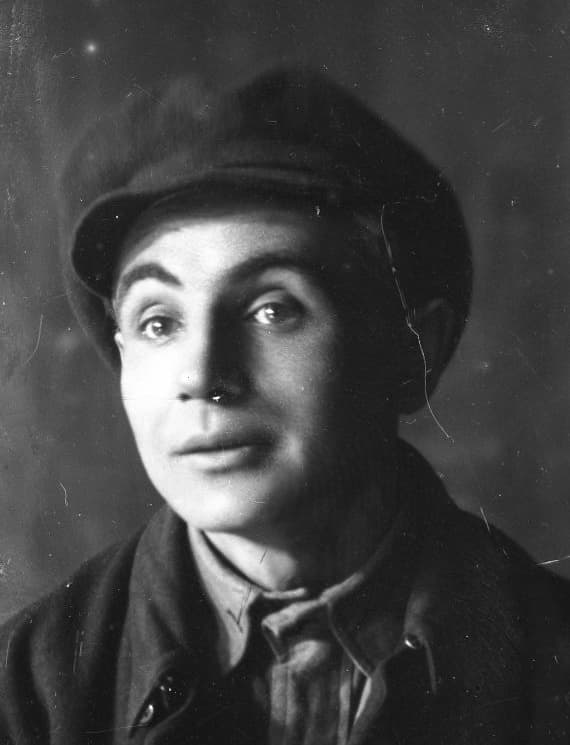Based on the play by Ivan Mykytenko
Premier: May 31, 1930
Director: Les Kurbas
Artist: Vadym Meller
Composers : Yulii Meitus, Mykola Koliada
Dudar – A. Buchma, F. Radchuk
Maloshtan – M. Krushelnytskyi
Nebaba – N. Yzhvii, S. Fedortseva
Chyrva-Kozyr – Y. Hirniak, O. Serdiuk
Piven – D. Miliutenko
Husak – O. Khvylia
Paranka – V. Chystiakova, N. Tytarenko
Nastia – N. Vashchenko
Horokh – O. Shutenko
It was not Les Kurbas’s decision to stage Ivan Mykytenko’s Dictatorship at the Berezil. In the late 1920s the influence of the soviet government on the theater was already noticeable. Journalist V. Butkivskyi wrote about situation in 1943: “Moscow, for its part, said either-or. If you are, say, in favor of building socialism, then put on Mykytenko’s and Russian plays. If you don’t want to, it means you’re a counter-revolutionary nationalist theater.” Yosyp Hirniak, the Berezil actor who played Chyrva-Kozyr, noted: “The second half of the 1929 season and first half of 1930 in Ukraine took place under pressure – unprecedented in the history of theater – from government circles on the selection of repertoires by the country’s theaters.”
It is under this pressure that Kurbas starts working on Dictatorship. As soon as Ivan Mykytenko’s play appeared, literary critics noticed in it a significant resemblance to Mykola Kulish’s 97. But this comparison didn’t benefit Mykytenko because his work was called “a weak imitation” and “a worthless copy” of the original. The play, which thanks to the party’s support was performed at many theaters, was ironically called “Mykytorship” by audiences. To increase his dramatic authority, pro-government newspapers called him the Ukrainian Shakespeare. But this title caused even more ridicule, and in Kharkiv and at Berezil they started calling him Vania Shakespeare.
However, theater critics wrote that the secondary symbiosis of plays by Kulish and Karpenko-Karyi in Dictatorship was transformed into a large-scale theatrical and musical productions thanks to Kurbas.
In the play, worker Dudar goes from the city to the village to put the villagers on the right path to socialism, persuading them to forcibly/voluntarily give up their bread and carry out the state plan. At the center of the conflict are poor Maloshtan, who can’t figure out what a dictatorship of the proletariat is, and kurkul Chyrva-Kozyr, who doesn’t want to give away his bread for the needs of the state.
Ivan Mykytenko was very flattered that Berezil, the best Ukrainian theater, was going to put on his play, but the playwright’s opinion of this collaboration changed after the premier. The director’s accents were placed with talent: some critics felt that the positive and negative characters switched places at times in the play. V. Butkivskyi noted that Kurbas made Maloshtan into a fool and the kurkul into a heroically tragic character; but he didn’t want to divide the characters into black and white: each of them was to be, first and foremost, a living person not an outline. Critic B. Simantsev noted that Maloshtan, in a brilliant performance by Marian Krushelnytskyi, became a true village philosopher, who can’t comprehend what a dictatorship is. The critic felt that Yosyp Hirniak, who played Chyrva-Kozyr, created a figure that will be remembered for a long time – he “was both fawning and vindictive, gentle and cruel.” Hirniak recalled that in his imagination, Chyrva-Kozyr was a courageous, strong-willed person capable of defending himself. His appearance and movements resembled the biblical prophet Moses. Chyrva had a powerful monologue in the scene where, according to theater critic Hanna Veselovska, he found his own social and psychological nature of the kurkul. “Cherva fell to the ground with a moan,” she wrote. “And the way he did this, the way he fell to the ground, the way he hugged it with his arms showed his tenderness and great love for his land.” The hero of the show’s posters – Dudar, played by the talented Avrosii Buchma – also made a strong impression on the audience. Critics wrote that Buchma created the image of a worker who was both gentle and determined.
Berezil actress Sofiia Fedortseva recalled that the three final performances of Dictatorship in the season were sold out and many critics called the play a huge victory for Kurbas’s theater. Reporter B. Simantsev wrote that this performance was epochal for Ukrainian theater. Dicatorship didn’t leave Berezil’s stage for four years.
Mykytenko’s reaction was the complete opposite. The playwright was outraged and furious. He was critical of Kurbas in the press and was the leader of the campaign against Kurbas and Berezil.
The director did a lot of work on the script of the play. He shortened some scenes, redid others, removed some plot lines and minor characters and made it into a sort of opera, a musical performance where, as Fedortseva recalled, “the audience almost didn’t notice when the actors went from talking to singing and vice versa.” Kurbas said: “The play should be instructional and by its nature the material lends itself to the format of an opera…. This doesn’t mean that you will be singing. It will be a musical show, where the tone of the dramatic language can sometimes switch to literal musical intervals. We use music. We add a choir where we can. The perception will be more operatic than dramatic…”
Director Les Kurbas and composer Yulii Meitus spent a lot of time at the piano working on the music for the play. Meitus produced 400 pages of notes for the score. They also recruited another composer to work on the play – Mykola Koliada. Hirniak wrote: “The music for Dictatorship gave the primitive propaganda piece a sense of arrogance.” There was also a score for the lighting, which the director and artist gave great importance to.
According to critics, Vadym Meller, Kurbas’s constant supporter, displayed his skill once again in Dictatorship. The production assistant, Mykhailo Verkhatskyi, described Meller’s set design: “They built a large panel on the stage made up of six parts, each 1 meter wide and 4-5 meters long. If necessary, each part could be raised 1-2 meters up and lowered. This design was very functional.”
One of the highlights of the play was the scene where kurkul Chyrva and middle class Piven and Syrovatka are waiting for Dudar to arrive. Each of them sat on an apron stage near their homes that was 50 cm high. All three hugged their homes tightly like children, not ready to give up their property, ominously whispering, recalling Cherkasyn’s “demons of sole proprietorship,” resembling the dogs near their doghouse.
Dictatorship became a new word in directing, and most critics, artists and spectators liked it, but at the time in pro-government circles it was no longer important whether it was a talented show or not – as long as it corresponded to the party line. The director wasn’t able to put his plan in the Procrustean bed of proper Soviet ideology: it cracked and once again showed that Kurbas was a genius and creatively independent artist. Attacks by pro-government enemies, who called the play a formalistic ploy and “Kurbalesia,” were completely unfair, but it was they who launched the countdown to the director’s destruction.

